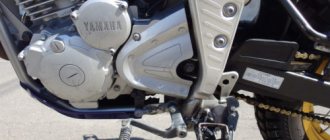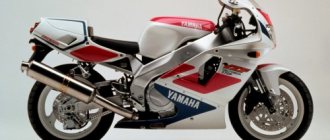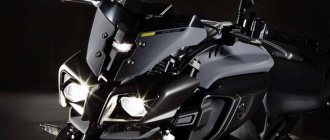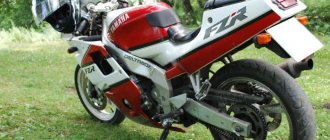This is an interesting motorcycle, which was a prominent representative of the road class in its time. Now this model is also popular, although it can only be purchased on the secondary market. Since people take this motorcycle from their hands, it means that the Yamaha XJ 400 Divershen is reliable.
Who is this bike suitable for? First of all, for connoisseurs of those road motorcycles that were produced in the nineties. The model is a shining example of a durable, easy-to-control and balanced bike that is suitable for both city streets and country trails.
Engine
Although the XJ 400 Diversion has a top speed of 160 km/h, do not cross the 130 km/h barrier, otherwise the wind protection will no longer cope with its task. The maximum performance of the local in-line four is small: it is only 35 Nm of torque and 42 hp. power.
Yamaha XJ 400 S Diversion (Diversion 400) motorcycle review
The engine is a modest 8-valve, oil-air-cooled. Then, everyone told me that this is a bicycle, a kind of Japanese sunrise, it doesn’t move at all. No doubt, the engine here is not from sport, but after the Soviet motorcycle industry its modest 42 were enough for me horses, although the PTS foolishly said as many as 50. At the bottom it pulls great, in a traffic jam you can start from 3, it will pull out, but it’s closer to 10-11 thousand, i.e. to the red zone, it turns sour. However, I didn’t anneal much on it, because I understood that the device was not designed for that, the maximum that I squeezed out was 170 km/h, then it was already a point press-press, and it simply blew me away with my then weighing 70 kilos with a considerable height of almost 2 meters))).
The motorcycle goes through a hundred in about 9-10 seconds. During a quiet ride, the average consumption is 5 liters, if you burn it out - 7, in the city, due to traffic jams, the average was 6-7 liters. On the highway, the tank is 17 liters at a speed of 100-120 km/h for 6 the transmission is enough for about 430 km - i.e. about a liter per 25 km or 4 liters per hundred, which I think is not bad for such equipment.
I will also note a somewhat rough throttle grip, or rather its sensitivity, which is generally not bad for a beginner, because it often happens that in order to control the gas, you need to very precisely dose the efforts on the grip, because the strokes of some motorcycles are minimal, i.e. I barely touched the gas and the revs soared like lightning. On Diversion this is not the case.
Box - this is where the Japs surprised me, why bother betting on a modest 400 cubes 6 (six)! a gearbox? For me, it’s just 5 and no more, but it didn’t bother me, there’s a joke with it. During the process of ownership, I forgot about 6th gear, although I turned it on a couple of times on the highway.
The gears themselves shift wonderfully, although it immediately became clear to me that the gearbox was clearly not designed for frequent active shifts (as in sports), the shift lever travel is somewhat large when compared with other 400s. Otherwise, the gearbox has no problems.
The suspension is a regular fork for road bikes, moderately soft, the ground clearance is good, you can easily steer along a country road and even force through puddles of medium depth. The center of gravity of the motorcycle is quite high, with all that it implies.
The brakes are single-disc on both wheels, they were enough for me during normal use, they stop well. Of course, when driving at high speeds, over 140 you want more effective braking, but this makes you more accurately predict possible maneuvers.
Landing, controls
The seating position on the Diversion is quite high, the mots is positioned as a classic. However, it’s comfortable to sit even with my considerable height of 185 cm, I didn’t get tired on long trips, although I didn’t travel more than 750 km at a time.
The lighting control knobs on the steering wheel are good, everything is simple, convenient and works great, the tactile sensations are also excellent.
The dashboard is simple, everything is perfectly readable, the only serious drawback in my opinion is that there is no fuel level indicator. You regularly need to look into the tank to see how much gasoline is splashing there.
One more thing - there is no oil pressure sensor here (though I don’t know exactly what type of sensor is usually installed on motorcycles) - there is a low oil level sensor, i.e. asks to top it up to the level on the window when it lights up.
The seat is two-seater, there are even handles at the back for the passenger to hold on to, but of course it’s really boring to ride on such a motz together, it’s even more or less so on a six-hundred-seater, and here, of course, you can carry a girlfriend, but it’s detrimental in any case. And it doesn’t fit the curb weight , if you constantly travel with two people, then it’s simply dangerous. Definitely a mots for egoists or 2 very flat-skinny Japs weighing 60 kilograms each.
Under the removable seat there is traditionally a battery, a fuse block, a small recess for small things such as a spark plug wrench and a pair of screwdrivers.
The standard headlight shines very well, no xenon is needed, although you can probably install it if you wish.
There is also such a feature - if you are about to start moving and the step is not removed, the motorcycle will stall.
Exploitation.
I used 92 gasoline, and at 95 the increase in power is small, but there is a chance of the spark plugs screwing up, this happened. Or the option is to fill it with 95 at proven gas stations, although in the end there is little point in this.
I used only Castrol synthetic motorcycle oil, I didn’t have any oil consumption, although at first it consumed about 250 grams per 2000 km, I changed the oil and filter and the burn went away, although Yamaha engines love to eat oil, I know this from other models. However, maybe this is the established pattern a stereotype, such as the oil burner in BMW engines. By the way, the oil level is convenient to control - there is a special window in the gearbox body. Changing the oil is also not difficult - there is a drain plug with a hexagon in the bottom of the crankcase.
In winter, the engine was parked in a regular garage, and the battery was taken home for the winter. In the spring, after hibernation, it started up quite vigorously.
During operation, several lights on the instrument panel died, so I removed the fairing cover and easily replaced it. A year after the purchase, the original battery died, I bought a good analogue of Moratti from Slovenia, it works great.
The seals on the fork have not leaked in the 12,000 km I have driven.
A year after the purchase, towards the end of the second season, the carburetor began to mope, the idle was acting up, I began to fill the spark plugs and the consumption increased - the seals dried out, some of the needles were covered, in general they sorted it out for me, they said that the carburetors on the Diversions were a weak point.
When I was already selling, it was the turn of the chain, it stretched for a little over 20 thousand, and with that I sold it.
That's actually all the problems.
Summary
It’s a pretty good motorcycle, it’s unlikely to be suitable for annealing and racing, but it will learn to drive in real conditions just fine. It doesn’t provoke you to unscrew the throttle and go to the point, like in sports. Predictable and adequate behavior. I recommend it if you come across a copy in good condition and for a reasonable price.
ZY Now I’m dissecting a Susa Jixer 750. Of course, after the Diversion, the Jixer is a space interceptor, a sports manned projectile. Looking at other Yamahas, nostalgia for the Diversion pops up in my head, I recently saw Yamaha again made the Diversion 600 cc, the design has changed but not much.
First motorcycle.
The agony of choosing a vehicle always overcomes everyone - whether you choose a Zaporozhets or a Bentley - it doesn’t matter. And when the first vehicle (a new category) is selected, the number of problems can be easily cubed. Of course, the best motorcycles for beginners are the Japanese 400 cc. And the best in terms of characteristics is the Honda SV400SF. But the prices go through the roof for 150 thousand. And a beginner still needs to buy equipment. We’ll leave driving in flip-flops and T-shirts to idiots, we’re not like that, right? For starters - helmet, jacket, gloves, knee pads. Motorcycle pants and boots - when the experience grows and there is a level-up. And don’t forget to change all the technological fluids in order to have a happily ever after...
Naturally, the choice began with reading specialized forums and communicating with familiar motorcyclists and motorcycle school instructors. Then the choice turned to the search for a specific device within a given budget. Avto.ru search gives you this opportunity - to quickly and reliably select. I set myself a budget of 100,000 rubles. I already had entry-level equipment. This bike was the second one I looked at. The first was a shaky Steed in the garage of some informal person.
If you need a 3-second boost to 100, a lot of pathos, being the first to fly away in traffic light races and other penis-extending tricks, this is NOT the place for you. The name “Diversion” seems to come from the fact that this version was the 4th in a row during design (letter D), so they decided to call it that; or some other delights of marketers.
If you need a simple, cheap (in terms of purchase and maintenance costs), full-size (for big guys), for learning how to actually ride a motorcycle in the city/highway, a reliable and unpretentious motorcycle for every day, this is an excellent choice.
At first I was a little confused by the air cooling of the engine, but it turned out to be a feature, not a bug. Thermal gaps in the motor, which are selected as the temperature increases, are a disadvantage that turn into advantages. General stunting (42 hp is not a racing figure at all), noise during operation are disadvantages, but forgiveness of mistakes (sharply unscrewing the throttle, careless operation of the clutch, incorrect landing, especially in corners), impossibility of boiling-overheating (if the cork is especially hard - the motorcycle simply stalls) - these are clear advantages of a motorcycle positioned as a motorcycle for beginners.
The oil required is the “to be used” grade (I used Motul 10w40, semi-synthetic), the usual consumables (but the brake pads are similar to YBR125, you must not confuse them), the fit is comfortable (I’m 1.82m tall and weigh 105kg).
By the way, the engine consumes a little oil (100-200 grams per 1000 km), depending on how much the handle is unscrewed. At rpms up to 7,000 there is no power at all, but if you turn it up more, it starts, yes... But you can forgive the old man.
I installed the bars (Crazy Iron) and the case (Biltema) myself.
Over the 5 years of ownership, there were no failures (the engine was from 1992!), but it dried out a couple of times on the highway, then there was a problem starting (you need to push it, some kind of another trick from the vacuum carburetor).
The weakness of the engine in the city is almost not felt, you are the first to leave a traffic light (if there is no Porsche nearby), but after 60 the acceleration weakens, and it is not interesting to turn a long-stroke engine. And the weakness of the frame is revealed in comparison when you sit on the next bike with an aluminum deltabox frame...
This mot is about something else. It's about preparing for the next moto. From the classic that it is (despite the sporty half-fairing), you can start both in the direction of sports and cruisers, and if you’re tired of the city and want to go to the bosom of nature, you can go to enduro. But to understand where you want to go, you need to drive a classic for 2 years.
Such as the Yamaha Diversion.
I want to share my opinion about the operation of the Yamaha Diversion 400 motorcycle. It is strange that most motorcycle enthusiasts do not take it into account, paying attention to the more popular models like the bandit and sb. I used this “device” to catch up on the season. No complaints! The dynamics are better than on Sat, we raced with a friend more than once. The pits are simply swallowed with a bang! Now I have a tourenduro, it’s almost the same on bumps. I read a lot of reviews that he is characterless and boring: 100% false! I don’t know, maybe after a liter they label it as sabotage, but after 7,000 and up to 11,000 it’s just a blast, the acceleration is amazing! Yes, it does not pretend to be a road bike or a cross-country bike, it is something in between, a universal everyday motorcycle without unnecessary inclinations. Came, started, went. By the way, it started up at -10 without any problems. Twist it a little and voila! By the way, the sabotage, having fallen on its side, scratched only a little of the plastic, having already shattered the device twice already, which costs 5,000 Chinese. So think about what is more practical 
Bottom line: I recommend it to everyone who switches to Japanomoto and for those who like to ride without problems and with pleasure. Thank you all for your attention 
The ergonomics and comfort of the motorcycle are beyond praise. Hence the excellent handling. Just like “a beautiful plane flies beautifully,” so a beautiful motorcycle rides beautifully. The elegant front fairing and windshield, although not large, are very effective at diverting oncoming air flows.
Cornering does not raise any special issues. However, the center of gravity is quite high. The seating position is very comfortable - straight, you don’t lean on the steering wheel, the seat is wide and soft, not only for the driver, but also for the passenger. You can travel quite long distances without getting tired. A good suspension also contributes to this. The front suspension, as they write in many tests, is really soft, which only affects the handling on the “washboard”, while the rear performs above all praise.
The engine runs great, responding instantly to throttle position. There is enough power, 42 hp, but for this you will have to add speed. The engine’s most favorite speed range is from 8 to 10 thousand (maximum speed – 11,200). Our measurements showed that the motorcycle reaches a speed of 100 km/h in ~9 seconds, which is quite good for four hundred cubic meters. At least, in suburban forwarding in the company of two CB-1s, I did not feel inferior. Excellent-looking exhaust pipes (mufflers) provide a dull, powerful sound, which distinguishes the Diversion from the rest of the 400s I know. Air cooling didn’t even have an effect when I, foolishly, made my way to the lake along a forest path in the heat of about 30 degrees in first gear (I don’t do such experiments anymore).
Yamaha gearboxes are not praised in tests. In particular, they write that they are not clear, however, if you don’t anneal them too much, there are no problems with switching. Maybe it's because I have nothing to compare with?
The lighting device copes well with its responsibilities. Particularly good is the low beam, which is scattered over a wide angle and gives the impression that you are driving a car with a pair of headlights.
Diversion is a good motorcycle and it will be a good school for beginners and those who have previously ridden a Soviet motorcycle. It was this motorcycle that contributed to the motorcycle sabotage in my life, in my consciousness. He and I literally burst into the world of Moto and bike culture. The motorcycle opened up a new degree of freedom for me, and I realized that there were no more boundaries. Everything is relative, and now I believe that the first step into the world of Moto was taken by me with Diversion. I think that I will take the next “first” step with the YAMAHA FZ400 fazer.
A normal airplane... I have one like this. Flexible, reliable and convenient (comfortable). Not for the annealer. I'm not going to change it.
Dimensions and weight
The bike weighs 201 kg including fuel. This is an average weight for a road bike. In particular, this mass is due to the tank volume of 17 liters, which, by the way, is absolutely sufficient given the gasoline consumption of approximately 6 liters per hundred kilometers. The seat height is quite small - only 770 mm.
Modifications
The older brother of the model is the Yamaha XJ 900.
The Diversion line was supplemented in 1995 with the XJ 900 model and until the end of 1994 consisted of three motorcycles with different engine sizes.
In 1993, after the development of the XJ 600 N, engineers tried to transfer this technology to the younger model. The symbol N stood for Naked (undressed, naked). The model had minimal external body kit .
This led to XJ 400 L. The main customers for this version were Japanese motorcycle schools. The potential consumer was still not interested in this.
Chassis and brakes
The pendants here are ambiguous. While the rear one is comfortable and copes well with its tasks, the same cannot be said about the front one. The local telescopic fork is quite weak; the XJ 400 Diversion can “peck” at the front when braking.
It is important to understand that this bike is not intended for aggressive riding. With smooth movement, it reveals its advantages in the best possible way. The brakes do a great job here, as long as you don't try to ride the XJ 400 Diversion like a sports bike. There is one disc installed at the front and rear, which is quite sufficient given the front diameter of 320 mm.
Specifications
Let's take a closer look at the technical characteristics of the motorcycle.
Power point
The well-proven engine from the 600 cc version was taken as the basis.
The Japanese did not reinvent the wheel when developing the engine for this model. They took an older model engine as a basis, cut down its characteristics, and put the resulting runt on a motorcycle.
4 pistons arranged in a row, operating on a 4-stroke circuit, were able to show the following characteristics:
- working volume - 399 cm3;
- power - 43 hp;
- number of valves - 8 (2 per cylinder);
- cooling - air;
- fuel supply - carburetor;
- ignition - electronic transistor;
- start - electric starter;
- tank volume - 17 l.
The indicators are not outstanding, but they fit exactly within the framework of Japanese legislation, which began to become stricter just during the years of production of this bike.
Transmission and clutch
Like the older version, the motorcycle has a 6-speed gearbox. There are no complaints about it, except that sometimes it’s quite difficult to guess the neutral.
They screwed up the transmission, there are a lot of complaints about the quality.
In addition to the initially large pedal travel, wear on the parts and components of the box was added.
- Switching according to the standard for sequential boxes . First, then neutral, second and so on until sixth. Skipping passes is not allowed.
- The drive to the rear wheel is a chain .
- The clutch is of the traditional Yamaxa type - multi-disc in an oil bath .
Brakes
Since the version is lightweight, the brakes are minimal.
Front
- number of disks – 1;
- diameter – 320 mm ;
- support – 2-piston ,
Rear
- number of disks – 1;
- diameter – 245 mm ;
- support – 1-piston .
ABS, as well as combined operation, was not offered.








